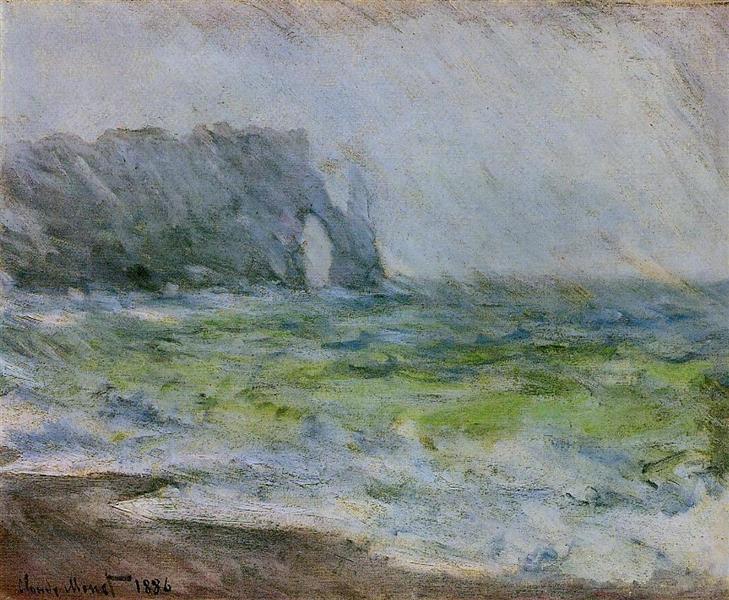Description
The work "El Manneport - Etretat in the rain" by Claude Monet, painted in 1886, is inserted in the context of the impressionist vision that the artist cultivated, where light and color become undisputed protagonists of the scene. Monet, a master Undisputed of the interpretation of the landscape, it evokes in this painting the unique atmosphere of the Manneport cliff, located on the Norman coast. The choice of the place is not accidental; Etretat was a favorite refuge of Monet, and its fascination with the forces of nature is evident in this work, where the climate radically changes the perception of the place and, in turn, of the painting itself.
The composition focuses on the majestic rock arch, which stands as a natural monument, delineating a horizon where the gray and rainy sky mixes with the sea. Monet uses a gloomy and subtle palette, predominantly the gray and blue tones that resemble a cloudy and humid sky. Loose and rapid brushstrokes transmit the sensation of movement and transience, essential characteristics of impressionism. Through its distinctive technique, Monet captures the essence of the moment, allowing the viewer to experience the sensation of the rain that falls on the landscape.
Although clearly defined human figures do not appear in this painting, the environment suggests an interaction with the environment. The presence of man is intuited through fishing boats that navigate in the agitated sea, insinuating the daily life of the Etretat community, which is dedicated to this activity in a changing and unpredictable landscape. This absence of explicit figures invites you to reflect on the relationship between nature and the human being, a recurring theme in Monet's work.
Water nuances contrast with the grays of the sky, creating a melancholic atmosphere that evokes serenity and introspection. The texturing of the painting, achieved with the brushstrokes, invites the viewer to approach and discover the subtleties that are hidden in each section of the work. The Monet technique here not only documes a landscape, but also reveals its emotional state and its subjective interpretation of the environment.
"The Manneport - Etretat in the rain" is aligned with other works of the period, in particular those that reflect Monet's interest in the same cliff in different conditions of light and time. Its landscape treatment in previous and subsequent versions shows an evolution in its relationship with the natural environment, where each work becomes testimony of a particular moment. In this sense, the origin of impressionism, with its focus on light, color and movement, is reaffirmed through this piece that is both a masterpiece and a study embedded in the transience of human experience in the nature.
In short, this work is not only a visual registration of the Norman landscape, but it is also a deep meditation on the passage of time and impermanence of life. Monet, with its sharp sensitivity and innovative technique, invites us to immerse ourselves in a world where nature and emotions intertwine, reminding us of the beauty that resides in the ephemeral. "The Manneport - Etretat in the rain" captures a moment in time, and through its color layers and its evocative atmosphere, will transcend in the consciousness of the spectator long after their eyes move away from the canvas.
KUADROS ©, a famous paint on your wall.
Hand-made oil painting reproductions, with the quality of professional artists and the distinctive seal of KUADROS ©.
Reproduction service paintings With a guarantee of satisfaction. If you are not completely satisfied with the replica of your painting, we refund your money 100%.

